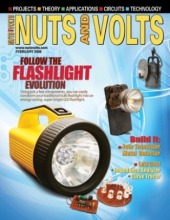Nuts and Volts Magazine
Features
A perfect wire should conduct a signal without adding noise, attenuation, or distortion. However, this isn't the case!
In the December ‘07 issue, we examined the various ways to hook up pieces of your home entertainment system to your HDTV. We specifically focused on the different video interfaces. We’ll continue now with the choices for passing audio from one device to another.
There are times when it’s extremely useful to know the voltage-current characteristic of a semiconductor device. Perhaps you’re matching two transistors or you need to determine the characteristic of some unknown surplus transistor...
One of the limitations of many low cost, single supply, analog-to-digital (A/D) converter ICs today is that they have a limited input voltage range. This article discusses various ways to implement input processing to allow these devices to operate in the real world. I use the ADS7870 as an example A/D, but the equations and samples are generic enough so that you can configure the circuits for other devices...
Projects
During recent years, with the advent of white LEDs, the ubiquitous household item — the traditional incandescent flashlight — is experiencing radical changes. It caught my attention when I noticed the many benefits LEDs can bring about; especially their energy-saving efficiency and the much brighter luminous intensity....
A voltmeter, signal generator, and a few parts combine to make a powerful impedance measuring tool.
Want to be a treasure hunter? By discerning subtle changes in frequency, this design is capable of detecting coins to a depth of three to four inches. The circuit can sense a soda can at a depth of six inches and metal pipes at an even greater distance. The unit is powered by two 9V batteries in series. The detector has a current draw of approximately 9 mA at 18 VDC. As a result, the batteries should last a long time...
Columns
TechKnowledgey
by Jeff Eckert
Techknowledgey 2008
Events, Advances, and News
Personal Robotics
by Vern Graner
Ping Pong Printer
In the December issue, I told you the story of The Ponginator — a 20-foot tall ping pong ball shooting, video screen sporting, light blinking, sound-blasting robot that the Robot Group built for Maker Faire in Austin, TX (Figure 1). The Ponginator was quite a hit, firing eight ping pong balls hundreds of feet out over the crowd every 30 minutes or so. Each ball was custom printed with the logo from The Robot Group and Maker Faire (Figure 2). Though a big success, one thing that sorta snuck up...
Q&A
by Russell Kincaid
Q&A
In this column, I answer questions about all aspects of electronics, including computer hardware, software, circuits, electronic theory, troubleshooting, and anything else of interest to the hobbyist.
PICAXE Primer
by Ron Hackett
Playing Music and Watching Lights
In the first installment of the PICAXE PrimeR, we took a look at the 08M’s music making capabilities and used the super simple “play” command to play “Rudolph the Red-Nosed Reindeer.” This month, we’ll expand our repertoire by exploring the “tune” command, which will enable us to play any tune we choose. As I mentioned last time, there are nearly 1,000 tunes available for free downloading at the Revolution Education website ([url=http://www.rev-ed.co.uk/picaxe/]http://www.rev-ed.co.uk/picaxe/[/url])...
The Design Cycle
by Fred Eady
Introducing the 32-bit PIC!
I can still remember fiddling with my very first PIC project, which was based on (at that moment in time) the brand new and unbelievable PIC16C54. I don’t recall ever complaining about the size of the PIC16C54 SRAM or its 1 µs instruction cycle time. And, I don’t recall ever filling up a PIC16C54’s program memory as we all programmed in assembler back then. As time passed, I quickly “outgrew” the PIC16C54’s limited I/O system (12 I/O lines) and moved up to using the “bigger” PIC16C55 device...
In The Spotlight
by Marvin Mallon
An Interview with Ray Bellantoni
Vice President of Marketing, Jameco Electronics
Departments
Modular Designs
by Bryan Bergeron
Instead of working with individual ICs and passive components, cost- and time-conscious engineers design and construct prototypes by working at the system level using function-specific modules.

